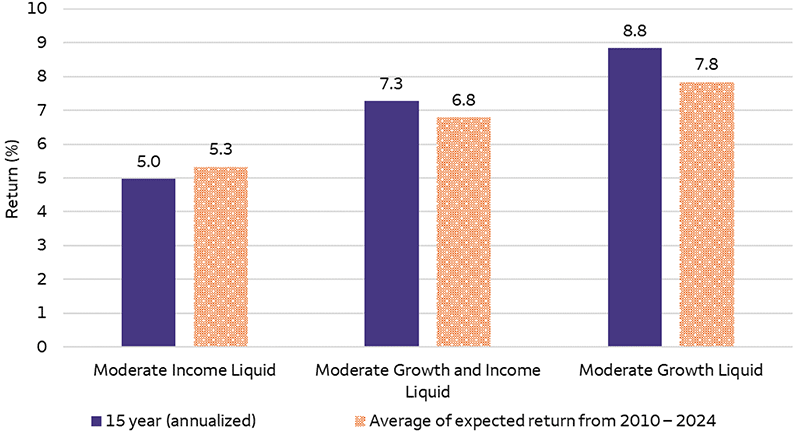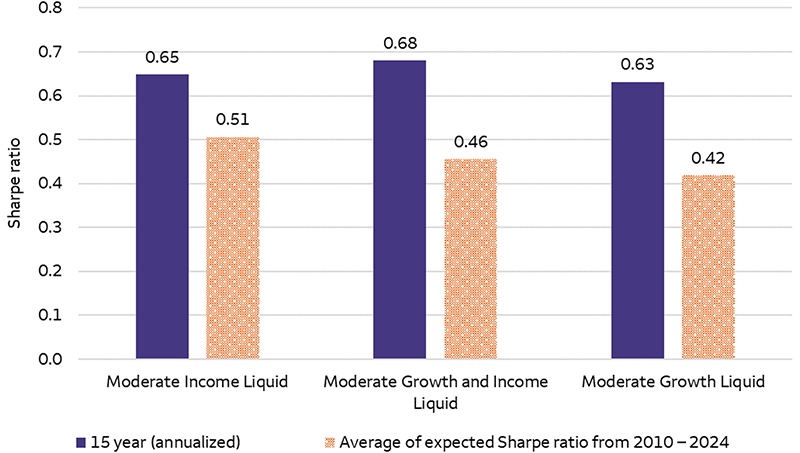We advise investors to select an asset allocation strategy deemed fit for their designated financial goals, time horizon, and ability and willingness to withstand market ebbs and flows. Our strategic allocations are based on capital market assumptions (CMAs) that reflect prospective trends over multiple market cycles.
As forward-looking estimates, CMAs are not guarantees of returns or risk. Rather, they are average annual estimates; actual performance for each calendar year will likely fluctuate around CMA estimations. As part of a comprehensive formulation process, we regularly review previous CMAs and consider factors to account for deviations from original estimates. This evaluation step helps to refine our CMA estimates going forward.
Performance results for the strategic allocations are for illustrative purposes only. Dynamic allocations change as needed with adjustments to the strategic allocations. Results do not represent actual trading and the results achieved do not represent the experience of any individual investor. In addition, results do not reflect the impact of any fees, expenses, or taxes applicable to an actual investment. The indexes reflect the historical performance of the represented assets and assume the reinvestment of dividends and other distributions. An index is unmanaged and not available for direct investment. Past performance does not guarantee future results. Different investments offer different levels of potential return and market risk. Please see below for the definitions and risks associated with the representative indexes.
Average of expected returns, risk, and Sharpe ratios from 2010-2024 are based on WFII’s strategic return and risk assumptions and strategic asset allocations from 2010 through 2024. Average of expected returns, risk, and Sharpe ratios from 2009-2023 are based on WFII’s strategic return and risk assumptions and strategic asset allocations from 2009 through 2023. For illustrative purposes. Forecasts are based on certain assumptions and on views of market and economic conditions which are subject to change. Strategic expected returns are forward-looking geometric return estimates from Wells Fargo Investment Institute of how asset classes and combinations of classes may respond during various market environments. Expected returns do not represent the returns that an investor should expect in any particular year. They are not designed to predict actual performance and may differ greatly from actual performance. There are no assurances that any estimates given will be achieved.
Capital market and asset class assumptions are estimates of how asset classes and combinations of classes may respond during various market environments. Expected returns represent our estimate of likely average returns over the next several market cycles. They do not represent the returns that an investor should expect in any particular year. Geometric return is the compounded annual return that would give the same result as a given series of annual returns based on those same assumptions. The return and risk assumptions are statistical averages that do not represent the experience of any individual investor or any specific time period. Standard deviation is a measure of volatility. It reflects the degree of variability surrounding the outcome of an investment decision; the higher the standard deviation, the greater the risk. The Sharpe ratio measures the additional amount of return that an investor could expect to receive for taking on additional risk.
CMA forecasts are not promises of actual returns or performance that may be realized. They are based on estimates and assumptions that may not occur.
The information does not take into account the specific investment objectives, financial situation and particular needs of any specific person who may receive it. Investors should understand that statements regarding future prospects may not be realized.
Conservative Income is composed of: 2% Bloomberg U.S. Treasury Bills (1–3 Month) Index, 76% Bloomberg U.S. Aggregate Bond Index, 3% Bloomberg U.S. Corporate High Yield Bond Index, 3% J.P. Morgan EMBI Global, 12% S&P 500 Index, 2% Russell Midcap Index, 2% Bloomberg Commodity Index.
Moderate Income Is composed of: 2% Bloomberg U.S. Treasury Bills (1–3 Month) Index, 60% Bloomberg U.S. Aggregate Bond Index, 4% Bloomberg U.S. Corporate High Yield Bond Index, 5% J.P. Morgan EMBI Global, 18% S&P 500 Index, 5% Russell Midcap Index, 4% MSCI EAFE Index, 2% Bloomberg Commodity Index.
Aggressive Income is composed of: 2% Bloomberg U.S. Treasury Bills (1–3 Month) Index, 47% Bloomberg U.S. Aggregate Bond Index, 6% Bloomberg U.S. Corporate High Yield Bond Index, 8% J.P. Morgan EMBI Global, 21% S&P 500 Index, 7% Russell Midcap Index, 7% MSCI EAFE Index, 2% Bloomberg Commodity Index.
Conservative Growth & Income is composed of: 2% Bloomberg U.S. Treasury Bills (1–3 Month) Index, 39% Bloomberg U.S. Aggregate Bond Index, 6% Bloomberg U.S. Corporate High Yield Bond Index, 5% J.P. Morgan EMBI Global, 23% S&P 500 Index, 8% Russell Midcap Index, 2% Russell 2000 Index, 7% MSCI EAFE Index, 4% MSCI Emerging Markets Index, 4% Bloomberg Commodity Index.
Moderate Growth & Income is composed of: 2% Bloomberg U.S. Treasury Bills (1–3 Month) Index, 30% Bloomberg U.S. Aggregate Bond Index, 6% Bloomberg U.S. Corporate High Yield Bond Index, 5% J.P. Morgan EMBI Global, 27% S&P 500 Index, 10% Russell Midcap Index, 3% Russell 2000 Index, 8% MSCI EAFE Index, 5% MSCI Emerging Markets Index, 4% Bloomberg Commodity Index.
Aggressive Growth & Income is composed of: 2% Bloomberg U.S. Treasury Bills (1–3 Month) Index, 20% Bloomberg U.S. Aggregate Bond Index, 7% Bloomberg U.S. Corporate High Yield Bond Index, 6% J.P. Morgan EMBI Global, 31% S&P 500 Index, 12% Russell Midcap Index, 3% Russell 2000 Index, 9% MSCI EAFE Index, 6% MSCI Emerging Markets Index, 4% Bloomberg Commodity Index.
Conservative Growth is composed of: 2% Bloomberg U.S. Treasury Bills (1–3 Month) Index, 16% Bloomberg U.S. Aggregate Bond Index, 3% Bloomberg U.S. Corporate High Yield Bond Index, 33% S&P 500 Index, 13% Russell Midcap Index, 5% Russell 2000 Index, 14% MSCI EAFE Index, 9% MSCI Emerging Markets Index, 5% Bloomberg Commodity Index.
Moderate Growth is composed of: 2% Bloomberg U.S. Treasury Bills (1–3 Month) Index, 8% Bloomberg U.S. Aggregate Bond Index, 3% Bloomberg U.S. Corporate High Yield Bond Index, 35% S&P 500 Index, 14% Russell Midcap Index, 6% Russell 2000 Index, 15% MSCI EAFE Index, 12% MSCI Emerging Markets Index, 5% Bloomberg Commodity Index.
Aggressive Growth is composed of: 2% Bloomberg U.S. Treasury Bills (1–3 Month) Index, 37% S&P 500 Index, 16% Russell Midcap Index, 7% Russell 2000 Index, 18% MSCI EAFE Index, 15% MSCI Emerging Markets Index, 5% Bloomberg Commodity Index.
Bloomberg U.S. Aggregate Bond Index is a broad-based measure of the investment grade, U.S. dollar-denominated, fixed-rate taxable bond market.
Bloomberg U.S. Corporate High Yield Bond Index covers the U.S. dollar-denominated, non-investment grade, fixed-rate, taxable corporate bond market. Securities are classified as high-yield if the middle rating of Moody’s, Fitch, and S&P is Ba1/BB+/BB= or below. Included issues must have at least one year until final maturity.
Bloomberg U.S. Treasury Bills (1–3 Month) Index is representative of money markets.
Bloomberg Commodity Index is comprised of 23 exchange-traded futures on physical commodities weighted to account for economic significance and market liquidity.
J.P. Morgan Emerging Market Bond Index (EMBI) Global is a U.S. dollar-denominated, investible, market cap-weighted index representing a broad universe of emerging market sovereign and quasi-sovereign debt. While products in the asset class have become more diverse, focusing on both local currency and corporate issuance, there is currently no widely accepted aggregate index reflecting the broader opportunity set available, although the asset class is evolving. By using the same index provider as the one used in the developed-market bonds asset class, there is consistent categorization of countries among developed international bonds (ex. U.S.) and emerging market bonds.
MSCI EAFE (Europe, Australasia, Far East) Index is a free float-adjusted market capitalization index designed to measure the equity market performance of developed markets, excluding the U.S. and Canada.
MSCI Emerging Markets Index is a free float-adjusted market capitalization index designed to measure equity market performance of emerging markets. MSCI makes no express or implied warranties or representations and shall have no liability whatsoever with respect to any MSCI data contained herein. The MSCI data may not be further redistributed or used as a basis for other indices or any securities or financial products. This report is not approved, reviewed, or produced by MSCI.
Russell 2000® Index measures the performance of the 2,000 smallest companies in the Russell 3000® Index, which represents approximately 8% of the total market capitalization of the Russell 3000 Index. Russell 3000® Index measures the performance of the 3,000 largest U.S. companies based on total market capitalization, which represents approximately 98% of the investable U.S. equity market.
Russell Midcap® Index measures the performance of the 800 smallest companies in the Russell 1000 Index, which represent approximately 25% of the total market capitalization of the Russell 1000® Index. Russell 1000® Index measures the performance of the 1,000 largest companies in the Russell 3000 Index, which represents approximately 92% of the total market capitalization of the Russell 3000 Index.
S&P 500 Index is a market capitalization-weighted index composed of 500 widely held common stocks that is generally considered representative of the US stock market.
1. The information contained herein: (1) is proprietary to Morningstar and/or its content providers; (2) may not be copied or distributed; and (3) is not warranted to be accurate, complete or timely. Neither Morningstar nor its content providers are responsible for any damages or losses arising from any use of this information.
Bonds: Investments in fixed-income securities are subject to market, interest rate, credit and other risks. Bond prices fluctuate inversely to changes in interest rates. Therefore, a general rise in interest rates can result in the decline in the bond’s price. Because bond prices generally fall as interest rates rise, the current low-interest-rate environment can increase the bond’s interest rate risk. Credit risk is the risk that an issuer will default on payments of interest and principal. This risk is higher when investing in high yield bonds, also known as junk bonds, which have lower ratings and are subject to greater volatility. If sold prior to maturity, fixed income securities are subject to market risk. All fixed income investments may be worth less than their original cost upon redemption or maturity.
Cash Alternatives: Cash alternatives typically offer lower rates of return than longer-term equity or fixed-income securities and may not keep pace with inflation over extended periods of time.
Commodities: Investing in commodities is not appropriate for all investors. Exposure to the commodities markets may subject an investment to greater share price volatility than an investment in traditional equity or debt securities. Investments in commodities may be affected by changes in overall market movements, commodity index volatility, changes in interest rates or factors affecting a particular industry or commodity. Products that invest in commodities may employ more complex strategies which may expose investors to additional risks.
Foreign: Foreign investing involves risks not typically associated with U.S. investing, including currency fluctuations, political instability, uncertain economic conditions, and different accounting standards. These risks are heightened in emerging markets.
Stocks: Stocks are subject to market risk which means their value may fluctuate in response to general economic and market conditions, the prospects of individual companies, and industry sectors. The prices of small/mid-company stocks are generally more volatile than large company stocks. They often involve higher risks because of smaller and mid-sized companies may lack the management expertise, financial resources, product diversification and competitive strengths to endure adverse economic conditions.
Wells Fargo Investment Institute, Inc., is a registered investment adviser and wholly owned subsidiary of Wells Fargo Bank, N.A., a bank affiliate of Wells Fargo & Company.
The information contained herein constitutes general information and is not directed to, designed for, or individually tailored to, any particular investor or potential investor. This report is not intended to be a client-specific suitability or best interest analysis or recommendation, an offer to participate in any investment, or a recommendation to buy, hold or sell securities. Do not use this report as the sole basis for investment decisions. Do not select an asset class or investment product based on performance alone. Consider all relevant information, including your existing portfolio, investment objectives, risk tolerance, liquidity needs and investment time horizon.
Wells Fargo Advisors is registered with the U.S. Securities and Exchange Commission and the Financial Industry Regulatory Authority, but is not licensed or registered with any financial services regulatory authority outside of the U.S. Non-U.S. residents who maintain U.S.-based financial services account(s) with Wells Fargo Advisors may not be afforded certain protections conferred by legislation and regulations in their country of residence in respect of any investments, investment transactions or communications made with Wells Fargo Advisors.
Wells Fargo Advisors is a trade name used by Wells Fargo Clearing Services, LLC and Wells Fargo Advisors Financial Network, LLC, Members SIPC, separate registered broker-dealers and non-bank affiliates of Wells Fargo & Company.
© 2025 Wells Fargo Investment Institute. All rights reserved.





 Sources: © Morningstar Direct, All Rights Reserved1, and Wells Fargo Investment Institute. Data as of December 31, 2024. Forecasts are not guaranteed and are subject to change. See end of report for important disclosures.
Sources: © Morningstar Direct, All Rights Reserved1, and Wells Fargo Investment Institute. Data as of December 31, 2024. Forecasts are not guaranteed and are subject to change. See end of report for important disclosures. Sources: © Morningstar Direct, All Rights Reserved1, and Wells Fargo Investment Institute. Data as of December 31, 2024. Forecasts are not guaranteed and are subject to change. See end of report for important disclosures.
Sources: © Morningstar Direct, All Rights Reserved1, and Wells Fargo Investment Institute. Data as of December 31, 2024. Forecasts are not guaranteed and are subject to change. See end of report for important disclosures. Sources: © Morningstar Direct, All Rights Reserved1, and Wells Fargo Investment Institute. Data as of December 31, 2024. Forecasts are not guaranteed and are subject to change. See end of report for important disclosures.
Sources: © Morningstar Direct, All Rights Reserved1, and Wells Fargo Investment Institute. Data as of December 31, 2024. Forecasts are not guaranteed and are subject to change. See end of report for important disclosures.